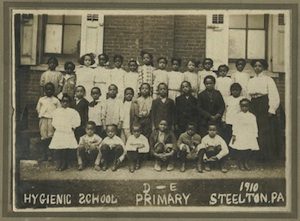
The Hygienic SchoolClass of 1910
*The opening of the Hygienic School in 1880 is celebrated on this date. This was a school for Blacks that opened during America's Reconstruction era.
Started in Steelton, Pennsylvania, the Hygienic School received its name from its location on Hygienic Hill, at Bailey Street between Adams and Ridge Streets. Steelton newspaper editor Peter Sullivan Blackwell conceived the school as a way to provide a quality education for the Black community's children and give employment to black schoolteachers who could not teach in white schools.
The Hygienic School started as a night school in the basement of Steelton’s Monumental A.M.E. Church and, by 1890, needed larger, more space for the expanding student body. One of the first organized protests by Steelton's Black population against the discriminatory practices of the school board was in 1890, when the board attempted to place the Black students in an old, ramshackle hall.
Blackwell and Joseph Hill organized the American Protective Association to oppose the school board's plans. The Association demanded that appropriate schoolrooms be built for the community's Black children or that they be given separate rooms in the high school. A compromise was made when someone suggested that the two rooms in the Hygienic Hill School could be used.
The commitment to education shown by Steelton's Black community was found in the strong role of the Black churches in support of the Hygienic School. Graduation ceremonies for Hygienic students completing the eighth grade were often held at local churches. When Steelton's Black citizens found that their children, who persevered through four more years at Steelton High School, were barred from joining the all-white alum association, they formed the Douglass Association.
Named for Frederick Douglass, its published aims were encouraging education among the local Black community and the "mental and moral improvement of its members." The Hygienic School continued to have an all-Black enrollment through the 1960s as the Supreme Court-mandated integration of Pennsylvania public schools was instituted throughout the commonwealth.
Although the building was torn down in 1974, Steelton residents and alumni fondly remember the school and its teachers. Many recall the close relationship between the teachers and students and believe that their education was equal to, if not better than, that the students received at better-funded and equipped white schools. "There's no one who attended that school that isn't proud to say so," declared Hygienic School alumnus Clayton Carelock at a recent discussion about the school's history.
Instead of being a reminder of racial segregation, the Hygienic School stood as a proud symbol of a community's commitment to education and self-reliance.
World Black History.blogspot.com
Gerald G. Eggert, Harrisburg Industrializes:
The Coming of Factories to an American Community
The Pennsylvania State University Press
University Park, PA, 1993), pages 91-97.